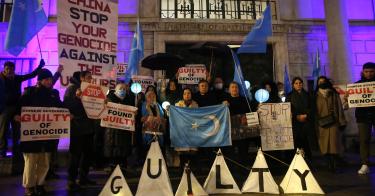On December 23, President Joe Biden signed into law the Uighur Forced Labor Prevention Act (UFLPA), a bill meant to ensure that no goods produced with forced labor in Xinjiang make their way into U.S. markets. While the bill’s passage was a victory for human rights in Xinjiang, the next 180 days are critical to ensuring the success and comprehensive coverage of the act.
The compromise bill establishes a “rebuttable presumption” that all goods produced in whole or in part in Xinjiang have been made with forced labor. U.S. companies will now be required to prove a negative: that goods they imported from Xinjiang are not produced with forced labor.
That’s well and good. But not good enough. By focusing strictly on Xinjiang, the bill does little to ensure that goods produced through forced labor by Uighurs, Kyrgyz, Kazakhs, and Tibetans and others outside of Xinjiang are not imported into the U.S.
Human rights advocates, civil society, and experts in the business and legal community should not rest on their laurels merely because the UFLPA was passed. Now is the time for action to meet several deadlines that will affect the U.S.’s long-term strategies to combat forced labor emanating from Xinjiang and China broadly.
>>> Four Ways To Hold Beijing Accountable During the Winter Olympics
First, the UFLPA requires the Forced Labor Enforcement Task Force created under the United States-Mexico-Canada Agreement (USMCA) to submit a request for public comment to the Federal Register within 30 days of the act’s passage. The notice for public comment extends beyond the geographic scope of the original rebuttable presumption to include the use of forced labor anywhere in China.
Second, 45 days after the deadline for submitting public comments, the task force is required to hold a public hearing to identify next steps to strengthen the U.S.’s response to China’s use of forced labor. Part of that charge is to identify best practices for monitoring supply chains to ensure compliance.
Third, the bill requires the task force, in consultation with the Secretary of Commerce and the Director of National Intelligence, to develop a strategy to ensure the enforcement of Section 307 of the Tariff Act of 1930. That section prohibits all goods produced with forced labor from entering the U.S.
It is vital that the task force strategy target goods produced with forced labor throughout China and identify those responsible—both individuals and entities—who may be ripe for sanctioning.
How the strategy is crafted is essential to ensuring that some of China’s worst forced labor practices are addressed. As advocates prepare their comments for the Forced Labor Enforcement Task Force, they should keep three issues in mind:
1) Any strategy addressing forced labor in China should extend beyond geographic Xinjiang. Without addressing things like China’s forced labor transfer programs (often disguised as “poverty alleviation” programs by the Chinese government), China’s use of forced labor in Tibet, and other challenges like the Chinese government’s historic practice of reeducation through forced labor, the act will fall short of its original goals.
2) Encouraging evidence-driven policymaking. Comments should encourage regular reporting requirements that document Customs and Border Protection’s (CBP) efforts to interdict goods produced with forced labor. Requiring an annual report documenting shipments of goods intercepted and investigated, estimates of their value and type of goods interdicted, and even sharing details on Chinese businesses perpetrating forced labor with industry in the U.S. will be helpful in crafting more effective strategies to combat future importation of goods produced with forced labor.
>>> How The U.S. Should Respond To Genocide In Xinjiang
3) Funding for CBP’s Forced Labor Division. Given the scope of the UFLPA, and its hopefully comprehensive strategy, a heavier burden will be placed on CBP to enforce the rebuttable presumption and previously implemented Withhold Release Orders related to the cotton, tomato, and polysilicon industries in Xinjiang. CBP is already under-resourced. As this 2021 Heritage Foundation paper argues, the agency’s Forced Labor Division needs additional funding just to meet pre-existing regulatory requirements. House Democrats have proposed a $25 million funding boost for the Forced Labor Division, to support “at least 75 [full-time employees], including training costs, to work on forced labor and would support improvements to technology.” This increase would go a long way towards ensuring CBP has the resources it needs to combat rising instances of forced labor abroad.
Successful implementation of the UFLPA is essential, not only to combatting forced labor in Xinjiang, but also to hold China accountable for one aspect of its ongoing genocide and crimes against humanity against the Uighur people.
This piece originally appeared in Forbes https://www.forbes.com/sites/oliviaenos/2022/01/11/ensuring-the-implementation-of-the-uyghur-forced-labor-prevention-act/?sh=3a0583365926



